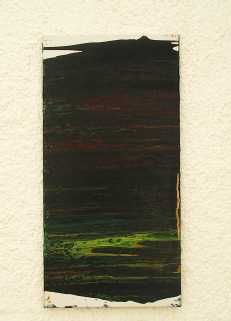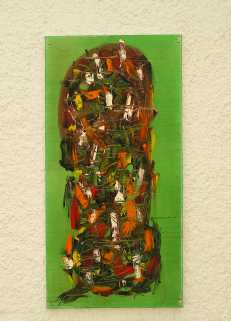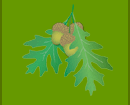 |
 |

|
|
|
 |
Paintings
Paintings
Australasia

Cause for concern in Australasia
| Australasia • Temperate Broadleaf and Mixed Forests |
 |
 |
Southland temperate forests
This area has been highly altered by human settlement, first by the Maori and then by Europeans. Much of the native forest and grassland has been converted to pastureland, a process that is continuing today. Feral and introduced animals such as possums threaten native plants, while introduced predators threaten native birdlife. |
| Download - Full Size (PayPal) |
|
|
|
|
|
Painting 00125 |
National Geographic's Wildworld |
| Australasia • Temperate Broadleaf and Mixed Forests |
 |
 |
Tasmanian Central Highland forests
Grazing by livestock and increased tourism are threats to this area. The ecoregion is also vulnerable to problems caused by global climate change. |
| Download - Full Size (PayPal) |
|
|
|
|
|
Painting 00126 |
National Geographic's Wildworld |
| Australasia • Temperate Broadleaf and Mixed Forests |
 |
 |
Tasmanian temperate forests
Eucalyptus trees are harvested for log, paper, pulp, and wood chip exports. The forest re-growth that occurs after clear-cutting is not suitable habitat for many species. Agricultural development and the clearing of land are also concerns, as is the introduction of invasive weeds and animals. |
| Download - Full Size (PayPal) |
|
|
|
|
|
Painting 00127 |
National Geographic's Wildworld |
| Australasia • Temperate Broadleaf and Mixed Forests |
 |
 |
Tasmanian temperate rain forests
The largest area of cool temperate rain forest is in northwestern Tasmania. A large portion of this area is protected as national parkland within the Tasmanian Wilderness World Heritage Site. Logging, mining, off-road-vehicle recreation, and invasive plants are all threats. Fire poses a major threat to Huon and King William pines, possibly contributing to localized extinctions of these plants. Many mammals that are rare on the Australian mainland are more common here, partly because of the large protected areas found here and partly because there are fewer introduced predators in Tasmania. The fox and the dingo, for example, were never introduced to Tasmania as they were on the mainland. |
| Download - Full Size (PayPal) |
|
|
|
|
|
Painting 00128 |
National Geographic's Wildworld |
| Australasia • Temperate Broadleaf and Mixed Forests |
 |
 |
Westland temperate forests
Land here is cleared for farming and used for grazing livestock. Possums, red deer, and other introduced herbivores damage the native vegetation, while introduced predators such as stoats prey on native species. |
| Download - Full Size (PayPal) |
|
|
|
|
|
Painting 00129 |
National Geographic's Wildworld |
| Australasia • Tropical and Subtropical Grasslands, Savannas, and Shrublands |
 |
 |
Arnhem Land tropical savanna
The area around Darwin is increasingly being developed for agriculture. Overgrazing, mining, fire, and introduced feral species such as swamp buffalo are all causes for concern as well. |
| Download - Full Size (PayPal) |
|
|
|
|
|
Painting 0130 |
National Geographic's Wildworld |
| Australasia • Tropical and Subtropical Grasslands, Savannas, and Shrublands |
 |
 |
Brigalow tropical savanna
The major threat to this ecoregion is clearing or severe modification of the vegetation. Several species are regionally extinct and a number of animals are totally extinct. Many native plant species are now dependent on marginal habitats such as steep, rocky slopes. Invasive weeds, feral animals, overgrazing, and soil erosion are all problems. |
| Download - Full Size (PayPal) |
|
|
|
|
|
Painting 0131 |
National Geographic's Wildworld |
| Australasia • Tropical and Subtropical Grasslands, Savannas, and Shrublands |
 |
 |
Cape York tropical savanna
This region is currently remote and unspoiled, but development and invasive species pose serious threats. The major land use is cattle and sheep grazing, which can and often does lead to vegetation degradation. Plans for development include timber and sugar cane plantations. Invasive species such as weeds and cane toads threaten native species. Conservation groups are lobbying to preserve the entire peninsula and enforce existing laws. Because many of the regionⳠinhabitants are Aborigines, this ecoregion represents an important opportunity to address native land rights and conservation together. |
| Download - Full Size (PayPal) |
|
|
|
|
|
Painting 0132 |
National Geographic's Wildworld |
| Australasia • Tropical and Subtropical Grasslands, Savannas, and Shrublands |
 |
 |
Carpentaria tropical savanna
Although this region may be isolated, cattle-grazing poses a serious threat for wetlands and forest areas. Extensive fires threaten rainforest patches and the rare animals found there. Introduced predators are causing problems for some small mammal species. The pale field rat, for example, was once found throughout this ecoregion. Now they only survive on offshore islands where introduced predators are yet not found. However, keeping cats and other non-native animals off these islands is a serious challenge. Invasive weeds are becoming a problem as well in wetland areas. |
| Download - Full Size (PayPal) |
|
|
|
|
|
Painting 0133 |
National Geographic's Wildworld |
| Australasia • Tropical and Subtropical Grasslands, Savannas, and Shrublands |
 |
 |
Einasleigh upland savanna
This ecoregion is one of the more populated tropical savannas. Overgrazing by livestock, the conversion of land to agriculture, and feral and introduced animals all pose threats. |
| Download - Full Size (PayPal) |
|
|
|
|
|
Painting 0134 |
National Geographic's Wildworld |
All paintings © Copyright EqualEarth.com on behalf of Van Xilef.
Australasia
|
 |
 |
|
 |
|

